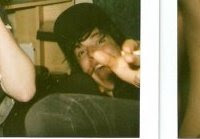Friday, 30 January 2009
Whatever you're doing, stop and dance
x
Finding time to capture the Friedmans...
I remember asking my mother when i was about 15, when Capturing the Friedmans was out on video if we could rent it out. The subject matter, disturbingly at the time, attracted me. Whether I sought to broaden my young, pretentious horizons as a result of reading too much Stephen King or not, I was refused and we rented some anodyne piece that I don't remember.
Looking back, I owe her my thanks. I don't think I would have been prepared for the ensuing tears I experienced viewing it today. Back then Kleenex mansize were unheard of, and I was a big boy, getting only bigger.
Whether you've watched the film or not, I'd appreciate if you'd read my brief critique on the nature of the film as docudrama.
x“Capturing the Friedmans” is perhaps the most emotionally exhausting docudrama I have ever seen. It concerns the portrayal of a family torn apart by charges (mainly testimonials) of child molestation, resulting in complete chaos and the dissolution of family values. The film explores a postmodern concept of ambiguity in a Reagan-era setting, shrouded in homophobia and a media open to speedy indictment. The ensuing frenzy is a tumultuous, often tortuous piece of documentary filmmaking that I at once admire and question.
The film succeeds outright in constructing a complex story of a family with deeply intrinsic problems. Much of the content is derived from home video, of which Arthur Friedman, the family father and his sons were great fans. The extensive amount of home footage eradicates the need for actors, thus giving the documentary a uniquely human, raw? view. This footage is interspersed with numerous interviews from policemen, abused students, the family themselves and investigators among many other contributors. The selection of footage and transitions used piece together the film adeptly, creating a seamless viewing experience that retains interest throughout. One particular early shot of David Friedman, a son uninvolved in the charges made, deconstructs to the viewer what much of the latter part of the film will entail. He is shot close-up, sat outside on some steps, casually dressed, the laidback setting contrasted by the uneasy way in which he answers the director’s questions. His body language suggests discomfort as he hides from the camera when questioned about his father. The simple setting is complemented by the only sound perceived being the rustling of wind around him. He is at once alone and afraid, almost a boy again, setting the scene for the ensuing content of people in a small, insular town being forced to engage with material and research that not only causes discomfort, but confusion. This central theme is focussed around the questions that arise concerning whether or not much of the evidence against the father and brother has any real validity.
The music, composed by Phillip Glass matches succinctly the images presented. For example, there are several sequences and transitions that feature the camera tracking along a road displaying perfect lawns reflective of notions of the American dream while simultaneously, a piano plays a foreboding tune accentuated by the non-diegetic sounds of children playing and police sirens that swerve in and out of the music. As the family begins to break apart, an investigator suggests that the family is completely dysfunctional. When they should be grouping together to form a defence, they are shown, again through home video footage to be arguing intensely. The shot then cuts to an accelerated image of the town clock winding furiously on as trains and cars speed by. The resultant effect is a powerful one, that although time and life move inexorably on, the family’s personal growth is significantly lacking.
The story itself concerns Arthur Friedman, who is charged with acquisition of child pornography and the subsequent charges of molestation as members of the computer club he ran began to report his apparent deeds. I must admit that from what I saw I believed Arthur to be guilty of the charges. For up until that point the sheer nature of the crimes and the length at which the former students would attest to their validity subconsciously persuaded me that it was true. As it became apparent that there was in fact no physical evidence of sodomy or sexual contact I was forced to question myself for being so easily led. This for me, was a powerful statement on the danger of relying on testimonials as hard evidence.
Where the documentary fails is in coming to a solid conclusion concerning the events and the reasons which led to them. As Chris Mooney of the Committee for Sceptical Inquiry (CSI) writes:
“For skeptics, Jarecki's Capturing the Friedmans, in which the director ignored his duty as a responsible documentarian to actually seek the truth --and was championed for this refusal by the media--should be very troubling.” (Mooney)
The argument for art over truth is at times, startlingly evident. In one memorable scene the mother recalls a distinct lack of sexual intimacy between her husband and herself. What could be interpreted as being a significant factor in the couple’s burgeoning polarity is instead subjected to a sequence from home video of the couple’s earlier, happier times, illustrated by their dancing while “You’re the one, who’s stolen my heart” plays. The scene is almost comical, abandoning any deep sense of meaning that could have in fact illustrated a most heart-wrenching key scene.
Despite the visceral emotion and sympathy the documentary successfully generates, as a viewer i was left with something of an intellectual and emotional void in my response to this film. Well constructed, yet ambiguous and surreal, Jarecki’s film feel incomplete. The truth remains hidden: the Friedmans only partially and inelegantly captured.

